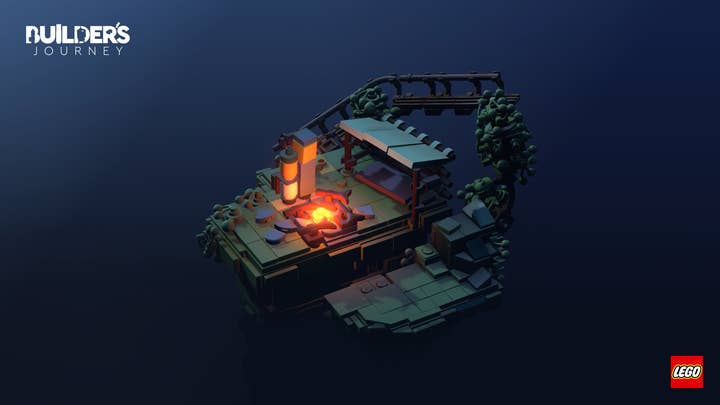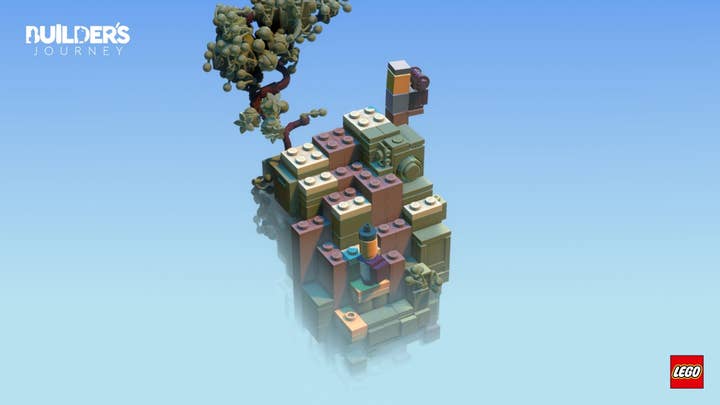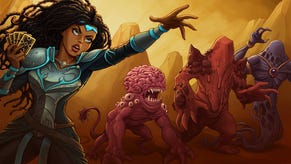Light Brick wants to rebuild how we play with digital Lego
Studio head Karsten Lund explains why Lego's new internal studio is getting back to basic building bricks with Lego: Builder's Journey
When you think of Lego video games, your mind likely jumps to one of the numerous Lego films or franchise spin-offs. Maybe The Lego Movie games, or Lego Harry Potter, Lego Batman, or Lego Star Wars.
In those games, players typically advance through familiar plotlines rebuilt in a Lego universe. They can usually fight by controlling different characters with simple attacks, and take advantage of the Lego building blocks of the universe by "building" or deconstructing tools or obstacles with the push of a button.
One thing you probably don't think of when you imagine Lego video games -- because it's rarely, if ever, explored in them -- is the simple act of placing one Lego brick on top of the other. And yet, that action is so integral to playing with Lego in real life.
"Brick-by-brick building, one brick at a time, is something that we haven't explored a lot in recent times"
That's why Lego established Light Brick, a new internal game studio of nine developers, according to its creative director Karsten Lund. Through Light Brick, Lund tells GamesIndustry.biz, Lego wants to find "new, different, and interesting" ways to digitally play with Lego, beginning with the core idea of the individual Lego brick in a new Apple Arcade-exclusive called Lego: Builder's Journey.
"Lego games stand for a lot of different kinds of play," Lund says. "We have a big action-adventure part of Lego play. But brick-by-brick building, one brick at a time, is something that we haven't explored a lot in recent times, and especially for touch screens, [we wanted to try and] see if we could mimic the physical feeling of building the bricks."
Light Brick describes Lego: Builder's Journey as a "poetic puzzle" that follows a parent and child on an adventure together, asking the player to solve puzzles by building with individual Lego bricks to help them proceed. Some of the puzzles require very specific solutions -- a bit out-of-character for a Lego game, but an incidental effect of the studio wanting to explore the puzzle genre in the first place. However, there are other areas that are more open to creativity and free building, which Lund says taps into the core values of the Lego brand and was necessary to make a Lego game... well, a Lego game.

"In these little diorama set pieces, we have a lot of puzzles that have more than one solution," he says. "Some of them are actually completely free; you can build your way through them the way you want to. Of course, we also have more narrative parts, and we have more mechanics-driven parts, but we actually have places in the game where whatever you build is up to you, and you decide how to go about solving the puzzle.
"In a puzzle game, there also needs to be solutions, and in order to keep the game fresh and challenging along the way, you need to have some kind of challenge in there. But I think we've managed to put some freedom and creativity within the solutions as well."
"The brick tells you so much about where it's going to go, how it's going to fit, and how it needs to be rotated and put together by just by the way it looks"
To accomplish Light Brick's goal of making a game that returned to the basics of what makes playing with Lego playing with Lego, the studio had to find ways to closely mimic the tactile feeling that so many are familiar with of actually snapping bricks together. For that to work, it made perfect sense to make Lego: Builder's Journey a mobile game.
"One of our early breakthroughs, especially on touch devices and phones, was the haptic feedback of actually clicking bricks together," Lund says. "You get haptic feedback when that happens, and that's very satisfying. We even supported 3D touch on the devices that had that feature, which means you can press a little bit harder on the screen, and it'll go a little faster. So you feel like you're really pressing bricks together.
"But other than that, it's the deliberate picking up a brick, deciding where it's going to go, rotating into its right angle, and snapping it right in place where you believe that it fits, that's the core mechanic of the game. And that is what is so satisfying about building with bricks, right? You recognize the shapes, and some of these shapes are actually 60 years old and still classic in design. The brick tells you so much about where it's going to go, how it's going to fit, and how it needs to be rotated and put together by just by the way it looks. So that's a strong language, I would say."

However, Lund mentions that Light Brick isn't necessarily a mobile-only studio. Though he can't yet discuss what the team's next project will be, he implies they're open to whatever platform makes sense to accomplish their goals of breaking down what it means to digitally play with Lego.
"We're huge fans of the mobile platform because it's so accessible, right?" he says. "And it's so social, and tactile if you will; you're literally sitting with the game in your hands. So it was a very nice fit for this concept, and it was great to build games natively for a platform. It's not like we are favoring any platforms.
"A lot of grown-ups tend to lean more into challenging play than free role-playing where they pretend to be something"
"But I think we just felt that mobile would be maybe the most diverse audience. You have a lot of different players, people who play a lot of games, people who do not play so many games, and a lot of people that come from different gaming backgrounds as well. So we had a feeling that this could actually work on a lot of different people. And we want to try and reach as broadly as possible with this title."
At the heart of Lego: Builder's Journey is its parent and child protagonists, who travel through each stage together in a manner almost reminiscent of Monument Valley 2 -- another puzzle game that also features a similar diorama style. But while Ustwo's mobile puzzle title may be the most obvious visual comparison, Lund acknowledges the relative novelty of a game focusing so closely on supportive parent-child relationships.
But, he says, it's a natural fit for a Lego game. Lund notes that most Lego games up to this point have been focused on the action-adventure genre, but have left little room for the more imaginative, creative role-playing familiar to anyone who's watched a child fly a Lego spaceship they've built around the room. With Lego: Builder's Journey, he says that Light Brick aimed to make a game that could be enjoyable by a wide age range, with younger players enjoying simply putting bricks together and older players able to tackle its more challenging puzzles later on.
Lund feels the core conceit of Builder's Journey -- to simply and creatively put one Lego brick on top of another -- is an important one for people of all ages.
"We need to remember to play no matter how old we get," he says. "And you differentiate how you play, the older you get. It changes, right? A lot of grown-ups tend to lean more into gameplay and challenging play than free role-playing where they pretend to be something. But it's actually a healthy thing to do for an adult as well, to actually play because that is where you sort of free up a lot of creative energy and that's where new things come from. That's where you try stuff that you wouldn't try anywhere else, and you come out of it richer and stronger.
"You don't need to tell that to a child, but we need to remember to do that as grown-ups, I think."









